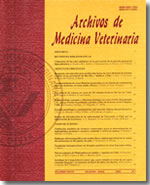Determination of the back load in horses used for Chilean rodeo and comparison with the estimated back load maximum capacity, in accordance with the Beltrán formula (1954)
Main Article Content
Abstract
This study was aimed to determine the weight supported on the back of the Chilean horse during the Chilean rodeo and to determine if this weight represents an overload for the animal, according to the Beltrán formula (1954). One hundred and forty registered Chilean horses, 74 geldings, 42 mares and 24 stallions (ages from 5 to 22 years) participants in rodeos at the O'Higgins Region were sampled. The height to the withers and girth in each individual was obtained in order to establish the back load maximum capacity. Riders and saddles were weighed to calculate the actual load supported by each horse and the actual percentage used of the maximun load was estimated. The results obtained indicate that Chilean rodeo horses present average height to the withers and average girth within the breed's standard. Among the horses assessed 32.15% had a height to the withers below the lower limit of the established breed standard, and 6.43% showed girth size below the standard. The actual back load obtained was in average of 93.4 ± 11.22 kg, being the rider's weight the main component of the total load. The estimated back load maximum capacity was in average 115.85 ± 6.07 kg. The relationship between the estimated back load maximum capacity and the actual back load showed that 3.57% of the horses assessed were overloaded, with an overall average for this ratio 80.78 ± 10.02%.

